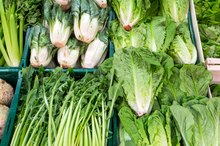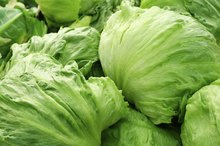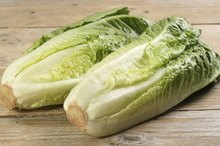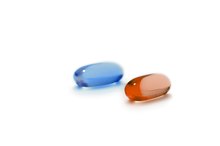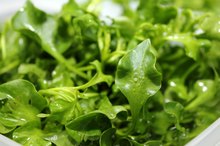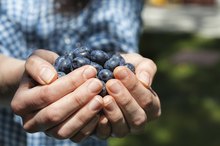What does fact checked mean?
At Healthfully, we strive to deliver objective content that is accurate and up-to-date. Our team periodically reviews articles in order to ensure content quality. The sources cited below consist of evidence from peer-reviewed journals, prominent medical organizations, academic associations, and government data.
The information contained on this site is for informational purposes only, and should not be used as a substitute for the advice of a professional health care provider. Please check with the appropriate physician regarding health questions and concerns. Although we strive to deliver accurate and up-to-date information, no guarantee to that effect is made.
Can Lettuce Thicken Your Blood?
If you bruise easily, if you have frequent nosebleeds or if your cuts take a long time to clot, you may be low in vitamin K and may be looking for a way to thicken your blood to increase its ability to clot. Lettuce is a vegetable that contains vitamin K, but the levels can vary greatly among the different kinds of lettuce and salad greens 3. Consult with your physician before trying to adjust your vitamin K levels to thicken your blood.
Vitamin K
Vitamin K is a fat-soluble vitamin and, according to the National Institutes of Health, is known as the clotting vitamin because it plays a major role in your body’s ability to form blood clots. Vitamin K can be found in a variety of green vegetables, fish, liver, red meats, eggs and some cereals. The Institute of Medicine’s Food and Nutrition Board recommends you consume 90 micrograms of vitamin K per day through your diet.
Iceberg Lettuce
What Vitamins Are in Lettuce?
Learn More
Iceberg lettuce is known for its crispiness, though it is low on flavor and nutrients, according to the Cook’s Thesaurus 3. In terms of vitamin K, iceberg has the lowest amount among the different types of lettuce. The USDA Nutrient Database shows that a 1-cup serving of iceberg lettuce contains only 17.4 micrograms of vitamin K. Iceberg lettuce also contains 215 micrograms of beta-carotene and 361 IU of vitamin A 2.
Red and Green Leaf Lettuce
Leaf lettuce comes in a loose-leaf bunch. A 1-cup serving of red leaf lettuce contains 39.3 micrograms of vitamin K, and the same serving size of green leaf lettuce contains 45.5 micrograms. With a recommended amount of 90 micrograms, one serving of these lettuces can provide as much as half of your daily vitamin K and help maintain your blood's ability to clot.
Romaine Lettuce
Vitamins in Iceberg Lettuce
Learn More
Romaine lettuce is traditionally used in Caesar salads 2. A 1-cup serving of romaine lettuce contains 48.2 micrograms of vitamin K. Romaine provides high levels of vitamin A and beta-carotene, with 2,456 micrograms of beta-carotene and 4,094 IU of vitamin A.
Butter Lettuce
Butter lettuce is a loose-leaf lettuce that includes Bibb and Boston varieties. Butter lettuce has a less crispy texture than other lettuce varieties have and tends to be softer. It can be used in salads and sandwiches and also can be used as a plate base to accent other food dishes. Butter lettuce varieties have the highest amount of vitamin K among the lettuces, with a 1-cup serving containing 56.3 micrograms of vitamin K.
- Butter lettuce is a loose-leaf lettuce that includes Bibb and Boston varieties.
- Butter lettuce has a less crispy texture than other lettuce varieties have and tends to be softer.
Considerations
Before trying to thicken your blood on your own through the addition of foods rich in vitamin K, consult with your physician. If you are at risk of heart disease or have had a previous heart attack and have been prescribed a blood-thinning medication such as Coumadin, let your physician know before adding large amounts of lettuce or other sources of vitamin K to your diet. The vitamin K in the lettuce can reduce the effectiveness of your medication, and your physician may need to adjust your dosage.
Related Articles
References
- Medline Plus; Vitamin K; Feb. 8, 2011
- USDA Nutrient Database; Lettuce, Cos or Romaine, Raw
- The Cook’s Thesaurus; Salad Greens
- Lettuce, iceberg (includes crisphead types), raw. FoodData Central. U.S. Department of Agriculture. Published April 1, 2019.
- How Nutritious Is Iceberg Lettuce?. Berkeley Wellness University of California. Updated 2019.
- Non-Starchy Vegetables. American Diabetes Association.
- Gordon B. How Much Water Do You Need?. Academy of Nutrition and Dietetics. Updated 2020.
- The American Heart Association Diet and Lifestyle Recommendations. American Heart Association. Updated 2017.
- Muñoz-García E, Luengo-Sánchez O, Moreno-Pérez N, Cuesta-Herranz J, Pastor-Vargas C, Cardona V. Lettuce allergy is a lipid transfer syndrome-related food allergy with a high risk of severe reactions. J Investig Allergol Clin Immunol. 2017;27(2):98-103. doi:10.18176/jiaci.0110
- Muñoz-García E, Luengo-Sánchez O, Moreno-Pérez N, Cuesta-Herranz J, Pastor-Vargas C, Cardona V. Lettuce allergy is a lipid transfer syndrome-related food allergy with a high risk of severe reactions. J Investig Allergol Clin Immunol. 2017;27(2):98-103. doi:10.18176/jiaci.0110
- Fontenot K, Johnson C, Williams B, et al. Lettuce. Vegetable Gardening Tips. Louisiana State University Agricultural Center. Updated 2014.
- Smith P, Polomski B, Shaughnessy D. Lettuce. Clemson Cooperative Extension Home & Garden Information Center. Updated 2017.
Writer Bio
Deborah Lundin is a professional writer with more than 20 years of experience in the medical field and as a small business owner. She studied medical science and sociology at Northern Illinois University. Her passions and interests include fitness, health, healthy eating, children and pets.
